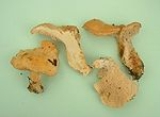
Hydnum
Encyclopedia
Hydnum is a genus
of fungi in the Hydnaceae
family. They are notable for their unusual spore
-bearing structures of teeth rather than gills. The best known are the edible
species Hydnum repandum and H. rufescens
. The word is derived from (h)udnon/ύδνον, an Ancient Greek
word for truffle. The white or buff Hydnum repandum has a spore scatterer of still another shape. The smooth cap
grows as wide as 8 inches across. The stem
is off-center and is less than 2 inches long. Hydnum has many brittle, white teeth from which the spores drop. The mushrooms of the Hydnum group grow both on ground and on wood. Some species have teeth which hang from ascending branches, while other species have teeth which project downwards from the undersurfaces of dead wood. Most Hydnum are safe to eat.
Genus
In biology, a genus is a low-level taxonomic rank used in the biological classification of living and fossil organisms, which is an example of definition by genus and differentia...
of fungi in the Hydnaceae
Hydnaceae
The Hydnaceae are a family of fungi in the order Cantharellales. Originally the family encompassed all species of fungi that produced basidiocarps having a hymenium consisting of slender, downward-hanging tapering extensions referred to as "spines" or "teeth", whether they were related or not...
family. They are notable for their unusual spore
Spore
In biology, a spore is a reproductive structure that is adapted for dispersal and surviving for extended periods of time in unfavorable conditions. Spores form part of the life cycles of many bacteria, plants, algae, fungi and some protozoa. According to scientist Dr...
-bearing structures of teeth rather than gills. The best known are the edible
Edible mushroom
Edible mushrooms are the fleshy and edible fruiting bodies of several species of fungi. Mushrooms belong to the macrofungi, because their fruiting structures are large enough to be seen with the naked eye. They can appear either below ground or above ground where they may be picked by hand...
species Hydnum repandum and H. rufescens
Hydnum rufescens
Hydnum rufescens, commonly known as the Terracotta Hedgehog, is an edible basidiomycete of the Family Hydnaceae. It belongs to the small group of mushrooms often referred to as the tooth fungi, which produce fruiting bodies whose cap undersurfaces are covered by hymenophores resembling spines or...
. The word is derived from (h)udnon/ύδνον, an Ancient Greek
Ancient Greek
Ancient Greek is the stage of the Greek language in the periods spanning the times c. 9th–6th centuries BC, , c. 5th–4th centuries BC , and the c. 3rd century BC – 6th century AD of ancient Greece and the ancient world; being predated in the 2nd millennium BC by Mycenaean Greek...
word for truffle. The white or buff Hydnum repandum has a spore scatterer of still another shape. The smooth cap
Pileus (mycology)
The pileus is the technical name for the cap, or cap-like part, of a basidiocarp or ascocarp that supports a spore-bearing surface, the hymenium. The hymenium may consist of lamellae, tubes, or teeth, on the underside of the pileus...
grows as wide as 8 inches across. The stem
Stipe (mycology)
thumb|150px|right|Diagram of a [[basidiomycete]] stipe with an [[annulus |annulus]] and [[volva |volva]]In mycology a stipe refers to the stem or stalk-like feature supporting the cap of a mushroom. Like all tissues of the mushroom other than the hymenium, the stipe is composed of sterile hyphal...
is off-center and is less than 2 inches long. Hydnum has many brittle, white teeth from which the spores drop. The mushrooms of the Hydnum group grow both on ground and on wood. Some species have teeth which hang from ascending branches, while other species have teeth which project downwards from the undersurfaces of dead wood. Most Hydnum are safe to eat.
Selected species
According to the Dictionary of the Fungi (10th edition, 2008), the genus contains 120 species.- Hydnum ambustum
- Hydnum dispersum
- Hydnum durieui
- Hydnum elatum
- Hydnum ellipsosporum
- Hydnum investiens
- Hydnum molluscum
- Hydnum papyraceum
- Hydnum repandum
- Hydnum rufescensHydnum rufescensHydnum rufescens, commonly known as the Terracotta Hedgehog, is an edible basidiomycete of the Family Hydnaceae. It belongs to the small group of mushrooms often referred to as the tooth fungi, which produce fruiting bodies whose cap undersurfaces are covered by hymenophores resembling spines or...
- Hydnum umbilicatum

